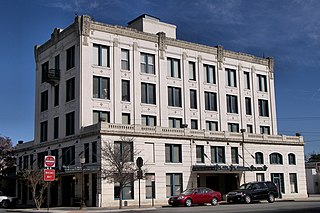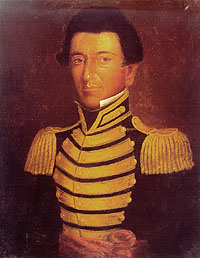Related Research Articles

Guadalupe County is a county located in the U.S. state of Texas. As of the 2020 census, its population was 172,706. The county seat is Seguin. The county was founded in 1846 and is named after Guadalupe River.

Seguin is a city in and the county seat of Guadalupe County, Texas, United States; as of the 2020 census, its population was 29,433. Its economy is primarily supported by a regional hospital, as well as the Schertz-Seguin Local Government Corporation water-utility, that supplies the surrounding Greater San Antonio areas from nearby aquifers as far as Gonzales County. Several dams in the surrounding area are governed by the main offices of the Guadalupe-Blanco River Authority, headquartered in downtown Seguin.
Sebastopol or Sevastopol is a city on the Crimean peninsula.

The Texas Hill Country is a geographic region of Central and South Texas, forming the southeast part of the Edwards Plateau. Given its location, climate, terrain, and vegetation, the Hill Country can be considered the border between the American Southeast and Southwest. The region represents the very remote rural countryside of Central Texas, but also is home to growing suburban neighborhoods and affluent retirement communities.

Rammed earth is a technique for constructing foundations, floors, and walls using compacted natural raw materials such as earth, chalk, lime, or gravel. It is an ancient method that has been revived recently as a sustainable building method.

Octagon houses were a unique house style briefly popular in the 1850s in the United States and Canada. They are characterised by an octagonal (eight-sided) plan, and often feature a flat roof and a veranda all round. Their unusual shape and appearance, quite different from the ornate pitched-roof houses typical of the period, can generally be traced to the influence of one man, amateur architect and lifestyle pundit Orson Squire Fowler. Although there are other octagonal houses worldwide, the term octagon house usually refers specifically to octagonal houses built in North America during this period, and up to the early 1900s.

Juan Nepomuceno Seguín was a Spanish-Tejano political and military figure of the Texas Revolution who helped to establish the independence of Texas. Numerous places and institutions are named in his honor, including the county seat of Seguin in Guadalupe County, the Juan N. Seguin Memorial Interchange in Houston, Juan Seguin Monument in Seguin, World War II Liberty Ship SS Juan N. Seguin, Seguin High School in Arlington.

Caliche is a sedimentary rock, a hardened natural cement of calcium carbonate that binds other materials—such as gravel, sand, clay, and silt. It occurs worldwide, in aridisol and mollisol soil orders—generally in arid or semiarid regions, including in central and western Australia, in the Kalahari Desert, in the High Plains of the western United States, in the Sonoran Desert, Chihuahuan Desert and Mojave Desert of North America, and in eastern Saudi Arabia at Al-Hasa. Caliche is also known as calcrete or kankar. It belongs to the duricrusts. The term caliche is Spanish and is originally from the Latin calx, meaning lime.

Sebastopol House Historic Site is an antebellum Greek Revival house built of concrete, located in Seguin, Texas, United States. Joshua W. Young built it between 1854 and 1856 for his sister, Catherine LeGette. Today Sebastopol is one of some 20 surviving buildings that give Seguin the largest concentration of early 19th century structures in the U.S.

Hempcrete or hemplime is biocomposite material, a mixture of hemp hurds (shives) and lime, sand, or pozzolans, which is used as a material for construction and insulation. It is marketed under names like Hempcrete, Canobiote, Canosmose, Isochanvre and IsoHemp. Hempcrete is easier to work with than traditional lime mixes and acts as an insulator and moisture regulator. It lacks the brittleness of concrete and consequently does not need expansion joints. The result is a lightweight insulating material ideal for most climates as it combines insulation and thermal mass.

Broad Margin is the name given to the private residence originally commissioned by Gabrielle and Charlcey Austin. It is located in Greenville, South Carolina, United States, was designed by Frank Lloyd Wright and was built by local builder Harold T. Newton in 1954. It is one of two buildings designed by Wright in South Carolina.

Guadalupe College was a private Baptist college for African Americans in Seguin, Texas. It was established in 1884 and opened officially in 1887. Its founding was chiefly due to the efforts of William B. Ball, who later became its president. David Abner Jr. was president of Guadalupe College from 1891 to 1906, a 15-year tenure during which the college flourished and gained statewide recognition. At its height during his administration, the college had an enrollment of approximately 500 students.

Leesville is an unincorporated city of 384 residents distributed over 51 square miles in the Gonzales—Guadalupe County, Texas area, electorally known as local Precinct 13; defined by the south of its Capote Hills at the “Leesville Quad” intersection and the north of Sandies Creek, twelve miles southeast of Seguin. Beginning in the 19th-century, the municipal identity of Leesville was founded upon being one of the first Justice of the Peace Precincts of its original county-area, as prescribed in the Texas Constitution; as well as once generally serving as the primary seat of a former Texas House District 90, once rated at more than 1,000 constituents. Straddling and nearing the southeastern border of Guadalupe County, the real estate origins of Leesville go back to the 1800s survey-plots of Texas Revolution figures Ezekiel Wimberly Cullen and Count Joseph de la Baume of France ; the latter retaining Texas's founding father Stephen F. Austin as an attorney, to reacquire the early-1800s Spanish land-tract, after Mexico's Independence from Spain in 1825. Divided by FM 1682 joining with Gonzales—Guadalupe County Road 121 West, Leesville's northern territory is closest to the Austin Metropolitan Areas through SH 80 / US 183, while the southern territory is closest to the San Antonio Metropolitan Areas through SH 97 / US 87.

Walnut Springs Park in Seguin, Texas is a network of walkways and bridges along the banks of Walnut Branch, a small tributary of the Guadalupe River. The stream is fed by various small springs. The main one near Court St. was filled in for parking, but the water still trickles out from the beneath the fill.
Arthur Swift (1812–1855) was a 19th-century Texas merchant, surveyor, political and military figure. He along with Rangers Mathew Caldwell and James Campbell were founders of Seguin, Texas and a member of Callahan's Gonzales-Seguin Rangers and a participant in the Texas–Indian wars. He served as a Texas State Representative for Gonzales-Guadalupe County.

Casa Navarro is a historic site in San Antonio, Bexar County, in the U.S. state of Texas. The original house complex was the residence of Texas patriot José Antonio Navarro (1795–1871), a rancher, merchant, leading advocate for Tejano rights, and one of only two native-born Texans to sign the Texas Declaration of Independence. Navarro first bought the property, about 1.5 acres, in 1832. The limestone, caliche block, and adobe structures were built c. 1832–1855, and Navarro moved onto the property soon after.

Saffold Dam at the Flores Crossing is a dam and man-made waterfall in the city of Seguin, Texas. Named for William Saffold, a Civil War veteran, a major landowner and local merchant. The dam was listed on the National Register of Historic Places on November 15, 1979.

Los Nogales is a historic 1800s home, among the oldest structures still standing in Seguin, Texas and is the last remaining adobe constructed home in the city. It serves the community as a museum.

The Magnolia Hotel is a historic structure located in Seguin, Texas. It was in operation as a hotel as early as 1844. The building had been in poor repair for a number of years and was added to a list of the most endangered historic places in Texas in 2012. In 2013, the structure came under new ownership and was being restored for use as a private residence.
References
- ↑ Hauser, Vincent (1980), The Concrete Era of Seguin Texas, p 54 and p 60
- ↑ Park Family Network (http://parkfamilyreunion.net/JohnEstenPark.htm)
- ↑ Maxon, Peter, Sebastopol Architectural Narrative, Austin, Texas: Texas Department of Parks and Wildlife, Historical Sites Branch
- ↑ Hauser, Vincent (May 1980), ' 'The Concrete Era of Seguin Texas' 'p.38
- ↑ Hauser, Vincent (1980), ' 'The Concrete Era of Seguin Texas' '
- ↑ Weinert, Willie Mae (1951). ' 'An Authentic History of Guadalupe County' '. Seguin, Texas: The Seguin Enterprise.
- ↑ Bicentennial Minutes, Seguin, Texas: Seguin Conservation Society, 1976
- ↑ Jones, Betty J., "Joshua and the House He Built", p 24, (Unpublished M.A. thesis, Southwest Texas State University, 1970.)
- ↑ Colonel Joshua Young House, Washington, D.C.: Historic American Buildings Survey National Park Service, 1934
- ↑ Olmsted, Frederick Law (1857). A Journey Through Texas, a Saddle Trip on the Southwestern Frontier. London: Sampson, Low, Son and Company.
- ↑ Maxon, Peter, ' 'Sebastopol Architectural Narrative' ', Austin, Texas: Texas Department of Parks and Wildlife, Historical Sites Branch
- ↑ Harris, Mrs Edwin (1986). ' 'Historic Homes The Charm of Seguin' '. Seguin: Seguin Conservation Society.
- ↑ National Register listing Sebastopol, Texas Historical Commission, Guadalupe County "THC - Atlas - County Search". Archived from the original on 2013-02-25. Retrieved 2012-09-03.
- ↑ Gretchen, Mark (2009). Slave Transactions of Guadalupe County, Texas. Santa Maria, California: Janaway Publishing.
- ↑ Gretchen, Mark (2009), Slave Transactions of Guadalupe County, Texas, Santa Maria, California: Janaway Publishing
- Fitzsimon, Rev. Laurence J. (1938). History of Seguin. San Antonio: C.H. Jackson Directory Company.
- Moellering, Max ( 1938) "A History of Guadalupe County." Masters Thesis. The University of Texas, Austin.